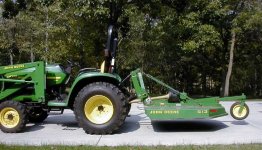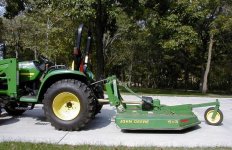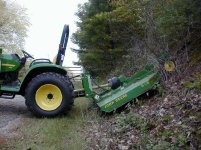beenthere
Super Star Member
- Joined
- Aug 16, 2001
- Messages
- 18,090
- Location
- Southern Wisconsin, USA
- Tractor
- JD_4x2_Gator, JD_4300, JD_425, JD_455 AWS, added JD_455, JD_110, JD_X485(sold)
Attached shows the use of chains in place of the steel strap bars to support the rear of the cutter. There are limitations to the steel strap bars that will cause them to bend, and the chains offer the flexibility but also the lifting ability for raising the deck for non-mowing travel. The raised position of the deck is also used when backing over brush to knock it down, followed by dropping down on the brush to chop it up.
This attachment shows the 'raised' position, with the use of the iMatch quick tach as well. Also, this Deere 513 deck was built-up along the lower rear skirt for better movement into brush without bending the skirt.
This attachment shows the 'raised' position, with the use of the iMatch quick tach as well. Also, this Deere 513 deck was built-up along the lower rear skirt for better movement into brush without bending the skirt.



